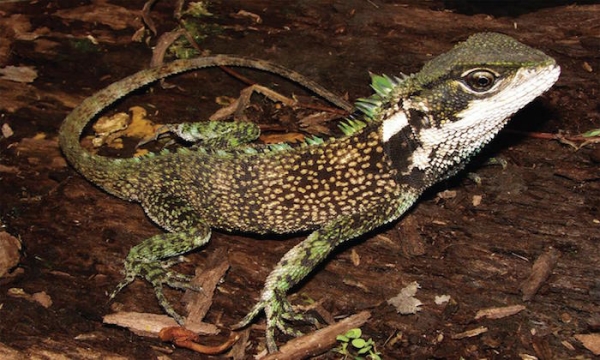Scientists Find Colorful 'Dwarf Dragon' Lizards in the Andes
| Marco Foronda | | Apr 07, 2015 07:29 AM EDT |
(Photo : Pablo J. Venegas) A male Enyalioides sophiarothschildae.
Researchers in Ecuador and Peru recently found three new lizard species that are colorful, spiky and only a few inches long. The lizards were discovered in the Andes and may be the cutest dragon stand-ins on Earth.
The three new varieties differ from their closest relatives in scale arrangement and coloration. DNA analysis confirmed the three new species' uniqueness. All three belong to the same genus: Enyalioides altotambo, Enyalioides anisolepis and Enyalioides sophiarothschildae.
Like Us on Facebook
"The diversity of these conspicuous reptiles has been underestimated," said study lead author Omar Torres-Carvajal of the Museo de Zoologia QCAZ in Ecuador.
Woodlizards grow to be between three and six inches (seven to 15 centimeters) long, making them one of the largest lizards in the Amazon rainforest. Researchers noted the lizards' colors and patterns help them blend into the environment.
The scientists were especially surprised to find three new species of woodlizards in such a condensed area as the reptiles are bright and colorful - making them hard to miss.
E. anisolepis is 5 inches-long (13 cm) and named after a Greek word that means unequal scales, referring to the differently sized scales on its back, flanks and limbs. This scaly lizard also has conical spikes sticking out of the back of its head.
Males are black and green while females are speckled pale brown. The species lives in both northern Peru and southern Ecuador between 2,375 feet and 5,715 feet (724 m and 1742 m) above sea level.
E. altotambo refers to the town of Alto Tambo, Ecuador, where the woodlizard was found. Both males and females looks like the thick-necked, warty dragon called "Gronckle" from the 2010 film "How to Train Your Dragon." Research suggests the species scales are all the same size, as well as their mitochondrial DNA.
In 2006, only six species of woodlizards were identified. The fieldwork of committed scientists has quickly changed that.
Details of the newly discovered lizards appeared in the latest issue of ZooKeys.
TagsScientists Find Colorful 'Dwarf Dragon' Lizards in the Andes Territory, Dwarf Dragon Dwarf Dragon, lizards, lizard species, Dwarf Dragon in Andes, Andes, peru, Ecuador, reptile, jungle animal, Woodlizards, New Species
©2015 Chinatopix All rights reserved. Do not reproduce without permission
EDITOR'S PICKS
-

Did the Trump administration just announce plans for a trade war with ‘hostile’ China and Russia?
-

US Senate passes Taiwan travel bill slammed by China
-

As Yan Sihong’s family grieves, here are other Chinese students who went missing abroad. Some have never been found
-

Beijing blasts Western critics who ‘smear China’ with the term sharp power
-

China Envoy Seeks to Defuse Tensions With U.S. as a Trade War Brews
-

Singapore's Deputy PM Provides Bitcoin Vote of Confidence Amid China's Blanket Bans
-

China warns investors over risks in overseas virtual currency trading
-

Chinese government most trustworthy: survey
-

Kashima Antlers On Course For Back-To-Back Titles
MOST POPULAR
LATEST NEWS
Zhou Yongkang: China's Former Security Chief Sentenced to Life in Prison

China's former Chief of the Ministry of Public Security, Zhou Yongkang, has been given a life sentence after he was found guilty of abusing his office, bribery and deliberately ... Full Article
TRENDING STORY

China Pork Prices Expected to Stabilize As The Supplies Recover

Elephone P9000 Smartphone is now on Sale on Amazon India

There's a Big Chance Cliffhangers Won't Still Be Resolved When Grey's Anatomy Season 13 Returns

Supreme Court Ruled on Samsung vs Apple Dispute for Patent Infringement

Microsoft Surface Pro 5 Rumors and Release Date: What is the Latest?










